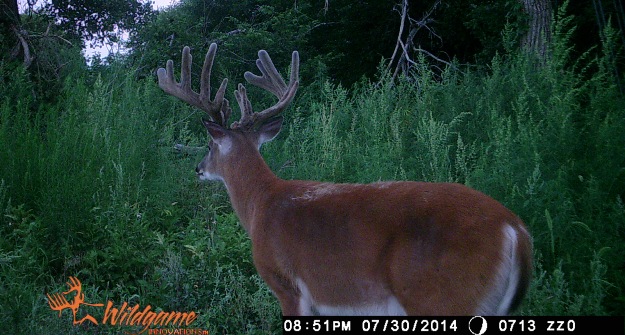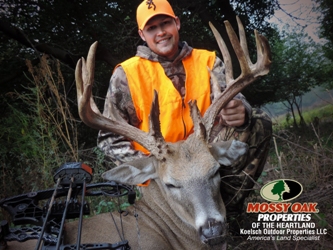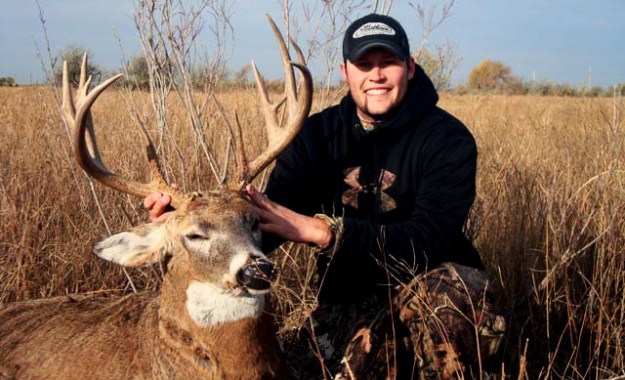
I saw the biggest buck that I’d ever seen when he would have scored about 170. He would have been a good trophy for any hunter. But I knew age and food produced the biggest bucks, so I let that buck walk after I first got pictures of him on my trail cameras. Each year for 3 years when I was getting pictures of this buck, I was really worried that someone else might find him and take him, or he might be killed by a predator, hit by a car or die of old age. I always would hunt this buck in the afternoons when he was moving from his bedding site and going to agricultural fields to feed. I was afraid to hunt him in the mornings because I thought I probably would spook him as I went into my stand site. An avid hunting friend of mine who lived in Texas told me, “You should try to take that buck on a morning hunt.” Of my 15 trail cameras, I had one trail camera that I could check with my cell phone. So, I put that trail camera under the ladder stand where I wanted to try to take that deer, to keep up with when he was moving up and down the nearby trail. The biggest reason I used this trail camera was to tell me where not to hunt this deer. I didn’t want to spook him before I had a chance to take him.
The first picture I got of this buck, his rack probably would have scored around 170. But when I took him 3 years later in 2014, he scored 193 on Boone & Crockett. However, his body was really small, and he looked like a greyhound. Although I knew he was a young deer, I also realized that his long, lean frame could carry more weight if he was older. I thought the buck was probably 3-1/2- to 4-1/2-years old. I also knew because of the direction he was traveling, which was north, that he was going toward the center of the property, where very few if any hunters would hunt. He should have a good chance to survive there for several years. So, I decided to take the chance to pass this buck up for 3 consecutive years to allow him to grow to his full potential. During those 3 years, the buck’s antlers continued to grow. He had kept his 170-inch frame rack but a lot of mass and numbers of kicker points added to his gross score. He also put on about 20-30 pounds of weight. One of the reasons I was able to take this buck and found a mature buck for my girlfriend, Annie Pieper, to take was to hunt when most other hunters didn’t hunt.
 During the first 2 weeks of bow season, Kansas weather often can be 100 degrees, the redbugs and mosquitoes are out, and the hunting conditions are miserable. So, I’ll have practically no hunting pressure on the buck I’m hoping to take. The other advantage of hunting early in the season is that the buck still will be on the same movement patterns that he’s been on all summer long. Also I’ve had time to trim shooting lanes and set up my ladder stands long before I’m going to hunt.
During the first 2 weeks of bow season, Kansas weather often can be 100 degrees, the redbugs and mosquitoes are out, and the hunting conditions are miserable. So, I’ll have practically no hunting pressure on the buck I’m hoping to take. The other advantage of hunting early in the season is that the buck still will be on the same movement patterns that he’s been on all summer long. Also I’ve had time to trim shooting lanes and set up my ladder stands long before I’m going to hunt.
Our bow season starts about the second week of September, and I took this huge buck on the 4th day of the season. I talked to my hunting friend in Texas after 3 days of not seeing my big deer in the afternoon, and that’s when he suggested I try to hunt him in the morning. I couldn’t sleep that night. I kept hearing my friend’s voice, “Hunt him in the morning.” So I got out of the bed, put on my Mossy Oak camouflage, picked up my bow and arrows and was on my tree stand 2 hours before daylight. I spotted the big buck at first light, and he stayed under my stand for at least 10-15 minutes past legal shooting time but never presented a shot. As the buck came in from the north, he would take 2-3 steps, stop and look in all directions before he would take 2-3 more steps. Since the wind was in my favor, I knew he couldn’t smell me, but I think he had a sixth sense that alerted him to danger. Although the buck was in range for about 10 minutes, I didn’t want to rush the shot or take a bad shot on a big buck like this. Finally, when the buck was 8 yards from me, I released my arrow, and the huge buck dropped immediately. I was almost sick at my stomach, because I always wanted to make a quick kill. I learned later that my drop away rest sometimes stuck, causing me to shoot high. So, I immediately let fly my second arrow, and the buck collapsed.
The first thing I always do when I take a nice buck is to call my dad. Dad had taught me how to hunt and why I should let young bucks walk to become big, mature bucks. My dad came to my stand to help me load up my buck. Dad doesn’t smile that much, but that morning, he was smiling as big as I ever had seen him smile.
Day 2: Ryan Koelsch’s Tactics to Hunts Bucks and Trophy Whitetails




























